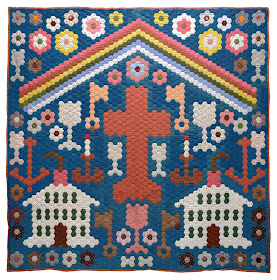 |
| "Drunkard's Path" c. 1890, sold to MSU Museum, MI. |
"History would be much easier if
everyone could get their stories straight."
|
The inclination to construct meanings for quilts leads to all kinds of stories about pattern names. "Drunkard's Path" is a prime example. The pattern is loaded with romantic baggage, but not everyone agrees on the story. It was included in the Underground Railroad Quilt Code hoax, said to indicate the irregular path slaves needed to use to avoid capture. It was also said to be a symbol of the Women's Christian Temperance Union, either invented or adopted by the organization to illustrate the path of the drunken husband, representing the evils of alcohol use.
Drunkard's Path is Brackman pattern #1461, from Ladies Art Company #46, published in 1895. There were several other names for the pattern, which appeared earier in some cases, but the publication date was around the turn of the century or later.
History would be much easier if everyone could get their stories straight. I would love it if people could take a time-out, and altogether stop making up stories about quilts...as if that would ever happen! The temptation is irresistible, and it creates a blurry line between fact and fiction. When and where did pattern names originate? How did they become popular? What function did the names serve? The romance of pattern naming is the stuff of legends.
 |
| Shealy Family Quilt, c. 1870, South Carolina |
There is little evidence to suggest pattern names were in use much before 1900. This information pretty much ruins the majority of romantic stories people tell about quilt pattern names, but it is all too easily swept aside when beliefs are held more dearly than historical facts. The real story, warts and all, is that many of the popular names for quilt patterns were products of the Colonial Revival and Depression era, when designers and copy editors assigned names as part of the marketing of patterns in newspapers and magazines.
Time to turn on the ultimate quilt mythology lie detector.
Are there quilts, or not?
Patterns, such as the 1930 Mountain Mist "New York Beauty" came with fictional accounts presented as historical fact. According to the pattern description, New York Beauty was "...a very old pieced pattern dating from 1776."
Time to turn on the ultimate quilt mythology lie detector. Are there quilts, or not? Are there any examples of the complex, geometric pieced quilts known as New York Beauty from the Revolutionary War period? No. Are there comparable examples suggesting a trend toward complex geometric patchwork at the time? No, it did not appear until much later, around the 1840s in America. Were there any records documenting this patchwork design in 1776? No.
I spent more than 25 years collecting and researching quilts made with the pattern, and never found one made before the middle of the 19th century. The Mountain Mist date, 1776, was most likely chosen by the pattern designer because of its patriotism and obvious significance in United States history. The information was further embellished with a note about the original, inspiration quilt being red, white and blue.
Mountain Mist maintained a collection of quilts, which was recently acquired by the International Quilt Study Center & Museum. One quilt, an old pieced quilt is thought to be the inspiration quilt for the "New York Beauty" pattern. It was made in the late 1800s or early 1900s, but certainly not in 1776. Incidentally, it was red, white and green. Mountain Mist's story failed the lie detector test in more than one way.
 |
1870s quilt made with a pattern that got its name later-
"Cross Roads to Bachelor's Hall" |
Not really knowing was better than making up stories.
Last year, I co-authored a research article for the American Quilt Study Group newsletter
with Marian Ann Montgomery, PhD, Curator of Clothing and Textiles at the Museum of Texas Tech University. The article was about the
"Cross Roads to Bachelor's Hall" pattern. Research began with an unidentified quilt I'd found. It clearly predated the initial publication and naming of the pattern, which raised questions about the pattern and name origins. Not really knowing was better than making up stories. We do not know what the pattern was called before 1906, but we know the design existed.
Cross Roads to Bachelor’s Hall was pattern number 2946 in the Encyclopedia of Pieced Quilt Patterns by
Barbara Brackman, and was attributed to Clara Stone. The pattern appeared in Practical Needlework: Quilt Patterns, published in 1906 by C.W. Calkins &
Company in Boston. The booklet was one of a series
containing patterns originally designed by Clara Stone
for periodicals published by Vickery and Hill Company
in Augusta, Maine.
Double Wedding Ring is another highly romanticized pattern name. Robert Bishop's 1989 book,
The Romance of Double Wedding Ring Quilts collected and examined more than 50 quilts in the search for the origins of the pattern. Bishop did not find any Double Wedding Ring quilts made before 1890, and today, the time frame is easily corroborated through documentation records on the Quilt Index, an online database with more than 50,000 records. These facts are problematic for supporters of fantastical stories about the pattern. Most Double Wedding Ring quilts were made in the 1930s or later.
It may be terribly unromantic to say when and where pattern names originated, but it's better than making up or repeating implausible stories. Pattern names were products of the mass media, the Colonial Revival and the Great Depression. The names were created by pattern designers and copy editors for newspapers and magazines publishing quilt patterns, starting around the turn of the century. Be wary of any stories that say otherwise, especially without written documentation from the appropriate period. Pattern naming...it's the stuff of legends.

















































